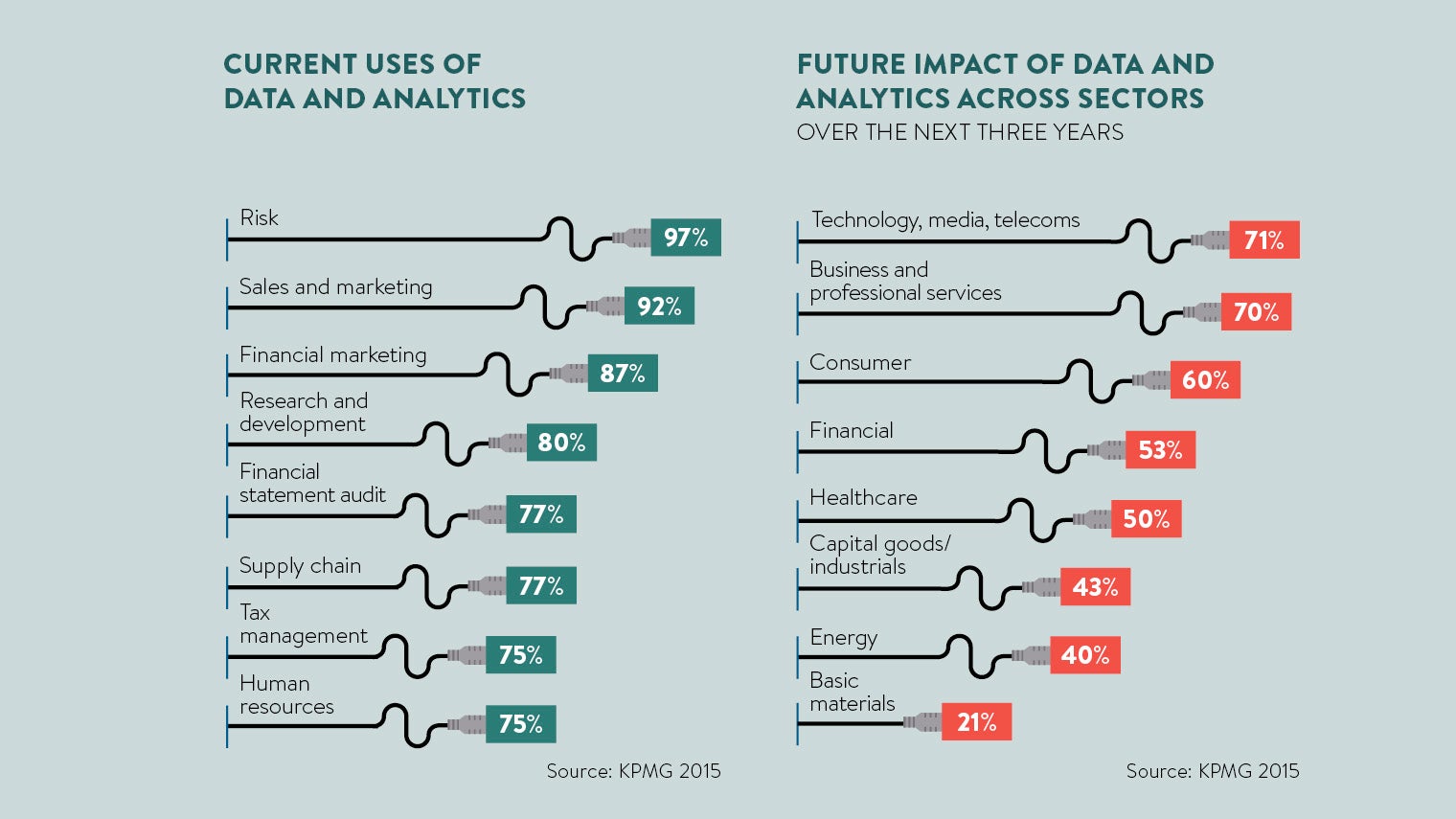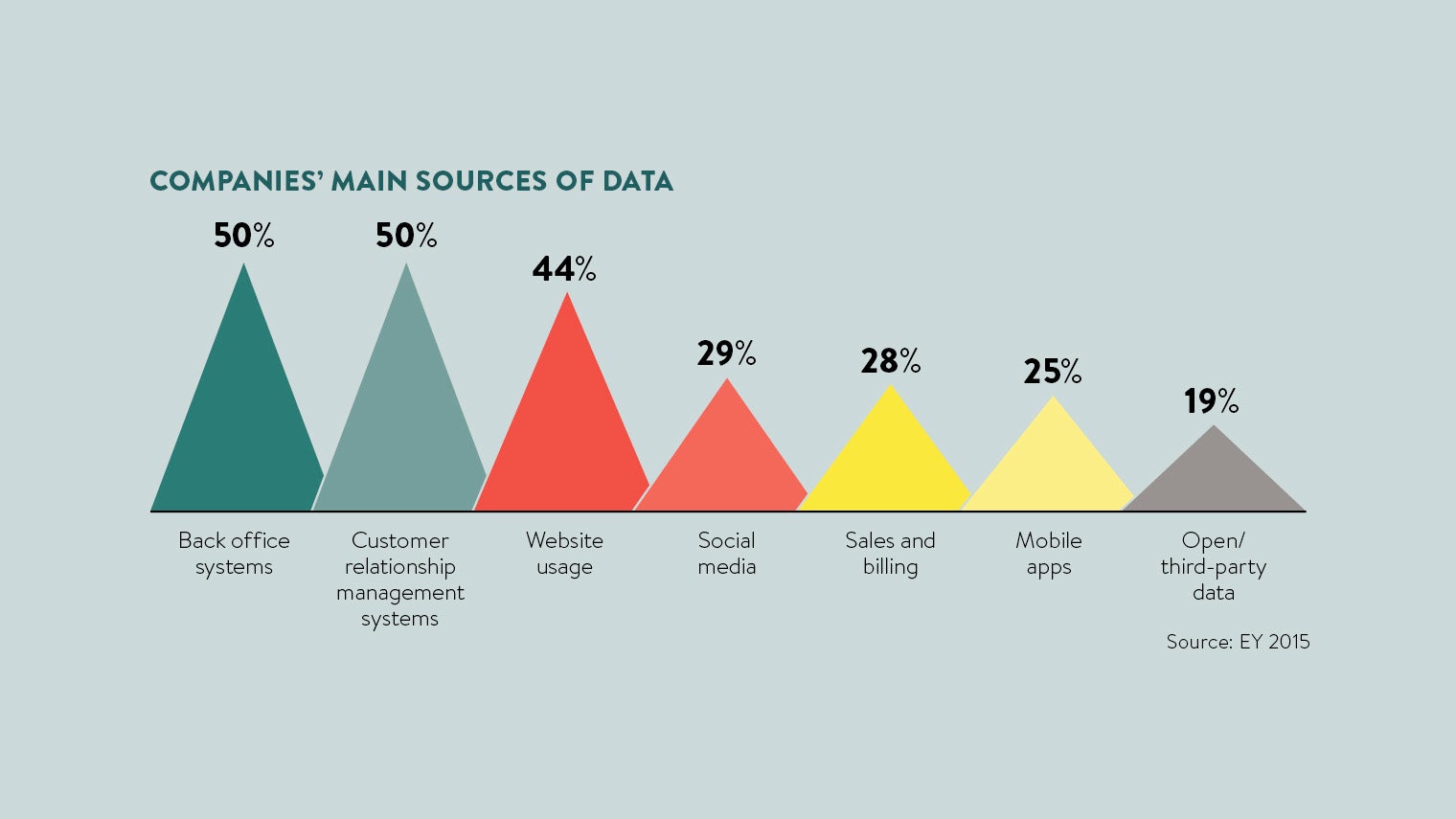Data analytics may be rooted in the workplace, but the internal story has long been a poor relation in a narrative firmly skewered towards the customer experience.
Benefits for end-users tend to offer the most tangible evidence of the rewards to be reaped when businesses take a more discerning approach to data management and forensically extract intelligence to fuel the service experience.
Click here for the full infographic
Reaching the full potential of the digital workplace
Mobile-aware technologies sending promotional offer alerts straight to customers’ phones from insight based on purchase history, is just one of many ways a once niche and complex practice has come to mainstream prominence.
Yet as more businesses harness intelligence to steal a competitive advantage, the drive to evolve their offering is increasingly underpinned by some game-changing transformation in the workplace. Knowledge is power and by putting it at the heart of an organisation’s culture, the repercussions can cut a swathe through established corporate hierarchies and overhaul even the most entrenched corporate environments.

“Linking data and analytics to behavioural and cultural change is emerging as the next challenge in addressing the full potential of the digital workplace,” says Gartner’s data analytics director Alan Duncan. “And it’s a transformation that requires business models and workplaces that are dynamic, opportunistic and collaborative to keep up with the rapid pace of disruption and change.”
The correlation is set to be felt more acutely as analytics emerge as a true market disruptor. Gartner’s latest findings bear out the trend with more than half of large organisations globally set to use advanced analytics by 2018, and most business users and analysts expected to access self-service tools by next year.
Analytics for a fuller picture
Indeed, this new breed of user-friendly solutions, which draw analyses into one central dashboard for easy access and collaborative decision-making, has been at the heart of this traction. An antidote to the standalone, costly and complex business intelligence reporting tools of old, by weaving and embedding data analytics inside a host of popular applications, intelligence is seamlessly integrated into most daily business processes.
Data science manager Heleen Snelting at TIBCO Software, a Silicon Valley-based analytics and enterprise software leader, behind data visualisation and analytics platform Spotfire, has seen the impact first hand across both the traditional analytics mainstay of financial services, manufacturing and energy, as well as new markets such as telecommunications, retail, education and healthcare. By displaying data visually and morphing statistics into graphics to provide an instant snapshot of the stories that could otherwise be buried in the numbers and spreadsheets, the approach is transforming how people work.

“We have a number of customers using self-service analytics for personnel-related topics, for example where a human resources department takes a data-driven approach to identify whether employees are allocated to tasks for which they have the appropriate skills and training,” she says.
“More broadly though, whenever you start to track and share key performance indicators through a visual analytics platform, change will come to an organisation. You begin to see surprise contributions from people with specific expertise, who you would not have expected to get involved. Thanks to the use of visual data, they can more easily justify and convince others that something is worth improving, an idea they may have been trying to highlight for years.”
Fostering proactiveness
Indeed, by changing the way that business intelligence tools are accessed, the practice is no longer the exclusive domain of data scientists or IT specialists, as analytics become cheaper and more accessible with major implications for smaller businesses where cost and complexity would have been prohibitive in the past.
In bringing insightful data to everyone’s finger tips, the implications run deep, with the potential to shape a culture where individuals generate findings and make the decisions themselves rather than awaiting instruction. As passivity shifts to proactivity to create a more level playing field, it’s a move that has earned the rather grandiose title of data democratisation.
It’s an approach in evidence at retail titan Marks & Spencer, where Spotfire’s self-service analytics has brought digital transformation and an open data culture to a 130-year-old British high street institution.
With people equipped to answer key business questions, their capabilities improve and the result is a more self-sufficient and informed workforce
Introduced to enhance productivity and bring greater cohesion to the customer experience, both historic data and forecasting capabilities have combined to drive service delivery improvements which span the breadth of the business. Drilling down into customer and supplier data has led to a more tailored offering, from better aligning the choice of ready meal with a particular branch demographic to a deeper understanding of the impact of seasonality on purchases. And for the businesses’ employees, the internal impact has been just as game-changing from head office right through to the front line.
“A shift in the dependency from IT to drive all the key database decisions has resulted in a major change to how we work which has brought data into the heart of every business decision,” says Pete Williams, head of enterprise analytics at M&S.
“Quite simply, analytics has become everyone’s responsibility. With people equipped to answer key business questions and make decisions far more quickly to solve their own issues, their capabilities improve and the result is a more self-sufficient and informed workforce.”
Of course, however convincing the benefits may be once in place, any cultural shift and change management is reliant on an organisation-wide buy-in to flourish, which usually means overcoming some level of resistance. And for the uninitiated, who may assume a data culture is little more than numbers and spreadsheets, establishing the case for data governance hasn’t always been the easiest sell.

Drip-feeding technology
“Business intelligence professionals are typically comfortable with the technical aspects of information delivery, but can struggle to influence business adoption and drive cultural change,” says Gartner’s Mr Duncan. “This is why we are seeing an increasing number of chief data officers and chief analytics officers charged with championing the transformational value of data and business analytics.”
It’s a tack that underpinned the approach at M&S, where Mr Williams became a visible and vocal proponent, focusing on the opportunities as opposed to positioning data as a solution to address any shortfalls.
A drip-feed approach to the technology gave employees the chance to see the benefits first hand and encouraged experimentation. By generating enthusiasm and allowing the new culture to develop organically, as opposed to the formal implementation of an IT roll-out, take up snowballed from ten initial users to two hundred.
[embed_related]
Mr Williams adds: “Most compelling is the transparency brought to so many areas of the business. Analytics has lifted the lid on the role of colleagues and departments that may have not been so widely known or understood. With information shared, the silos that had developed as employees worked on their own databases have made way for integrated communities which share intelligence as different departments work more closely together.”
With an eye to the future, the technology is also set to strengthen the retailer’s position to appeal to the kind of specialist technology talent needed to secure ongoing competitiveness which usually swarm to the tech hubs of East London and may not have considered retail as a sector.
And this bearing on recruitment and retention reinforces the inextricable link between analytics and people. While technology in the workplace can often find itself lazily cast in a diatribe that pits man against machine, here the reliance on human insight to extrapolate the insight collated has established an enduring and symbiotic relationship rather than an “either/or”.
TIBCO’s Ms Snelting concludes: “Human expertise is absolutely needed and can be used much more effectively as repetitive tasks are automated, freeing up the person to focus on something far more satisfying and impactful. Analytics is never a threat, just an opportunity.”
Reaching the full potential of the digital workplace

Analytics for a fuller picture






